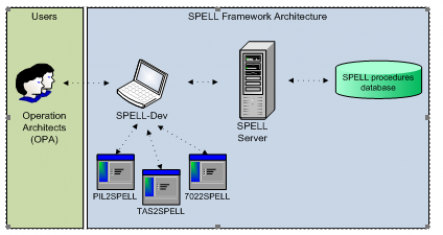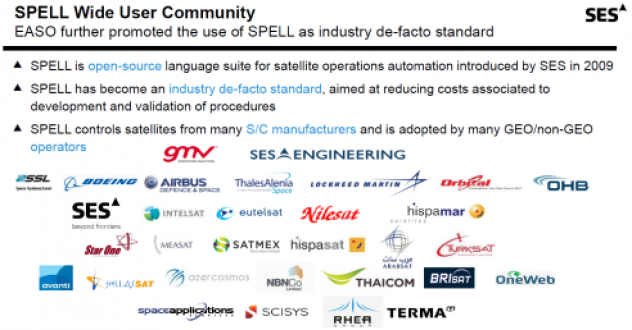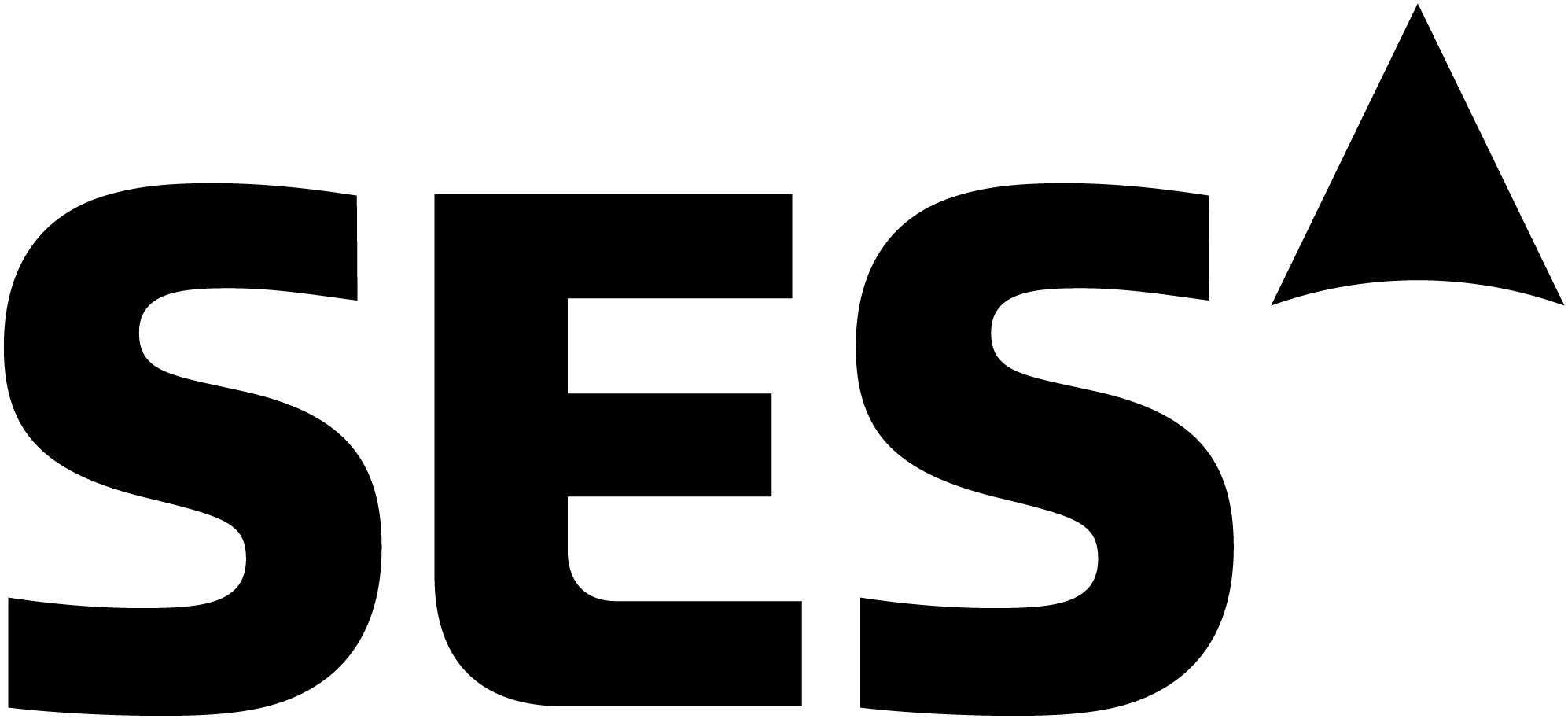
-
StatusCompleted
-
Status date2017-01-18
-
Activity CodeAB.XYZ
From 2011 to 2018, SES launched 18 new GEO satellites. In the context of SES' satellite fleet expansion, there has been an inherent need to:
- Increase the productivity of satellite controllers; and
- Increase the level of standardization and safety in SES' satellite operations.
This was achieved by expanding the use of SPELL in SES' satellite fleet. The EASO project was strategically aligned with SES operations strategy and SPELL objectives, and particularly aimed to:
- Develop the bus and/or payload SPELL procedures;
- Develop the automatic translator software tools (PIL2SPELL, TAS2SPELL, 702HP2SPELL, 702SP2SPELL);
- Enhance the SPELL and GCS software for DTP payload operations (SES-12, SES-14);
Enhance the SPELL-fuzz software tool for automated verification of SPELL procedures.
The main challenge of the EASO project was to evaluate if it is possible to develop 100% automatic and error free translators. The experience with the PIL2SPELL, TAS2SPELL, 702HP2SPELL, 702SP2SPELL automatic converters has largely demonstrated that this approach is extremely efficient compared to manual development, in cases where the procedure baseline is mature and consistent. These XXX2SPELL automatic converters have been used to generate a large number of SPELL bus procedures, which are used in satellite operations with reduced validation effort. The design of automatic translators is based on innovative technologies such as Algebraic Graph Transformation (AGT) and Triple Graph Grammar (TGG) in order to convert structure patterns into the corresponding SPELL patterns. The PIL2SPELL automatic translator was designed and implemented in collaboration with the University of Luxembourg (SnT). Due to the promising results of PIL2SPELL automatic translator software, the original project’s scope was extended with the inclusion of the development of automatic translator software for additional satellite manufacturers’ bus procedures, i.e., TAS2SPELL, 702HP2SPELL, 702SP2SPELL converters.
Moreover, there were additional key challenges and innovation aspects addressed as part of the EASO CCN#2 in particular, such as:
- SES-12, SES-14 and SES-15 satellites refer to High Throughput Satellites (HTS) which corresponded to a major technological change with respect to EASO original contract. In fact, these are the first GEO HTS satellites in SES fleet. As such, this was a major technological challenge addressed in EASO CCN#2.
- SES-12 and SES-14 satellites carry a DTP Payload, which heavily impacts the development of the SPELL Payload procedures. SES-12 and SES-14 DTP Payload has an impact on the SPELL and GCS. These SPELL and GCS enhancements due to the DTP payload constituted a major technological challenge and added-value addressed in EASO CCN#2.
- The Operations Concept for SES-16 (GovSat-1) satellite is innovative due to its G&I (Government & Institutional) / Security related mission. This constituted another innovation aspect addressed in EASO CCN#2.
Use of new automated verification approach to verify SPELL procedures: SES has been actively working on a new concept of automated verification called SPELL-fuzz which would dramatically increase the efficiency of the manually developed procedures, performing an automated verification without GCS/DSS in the loop, assuring high code coverage (target >90%) and allowing early detection of bugs/typos. EASO CCN#2 provided the opportunity to use and to further improve this new automated verification tool SPELL-fuzz in order to verify the manually developed SPELL procedures for SES-16 (GovSat-1) satellite.
Thanks to the valuable support from the ESA ARTES programme and the Luxembourg Government, the EASO project has enabled SES to:
- Increase the productivity of SES satellite controllers
- Make more efficient use of SES engineering resources
- Reduce the SES operational costs
- Increase the level of standardization and safety in SES satellite operations
Widen the SPELL user community, making SPELL an industry de-facto standard
The EASO product features can be summarised as follows:
- Set of XXX2SPELL software tools that allow 100% automatic conversion of bus procedures from 3 prime satellite manufacturers (Airbus Defence and Space, Thales Alenia Space, and Boeing) into SPELL bus procedures. In particular: PIL2SPELL for Airbus D&S' Eurostar 3000 Platform, TAS2SPELL for Thales Alenia Space's SpaceBus 4000 Platform, 702HP2SPELL for Boeing's 702HP Platform, and 702SP2SPELL for Boeing's 702SP Platform.
- SPELL payload procedures for 19 SES satellites from Airbus Defence and Space (D&S), Space System Loral, Orbital Sciences Corporation, Thales Alenia Space and Boeing;
- SPELL bus (platform) procedures for 8 SES satellites from Space System Loral, Orbital Sciences Corporation and Thales Alenia Space, which have been manually developed, and also for 8 SES satellites from Airbus D&S, which have been automatically generated with the PIL2SPELL automatic translator software tool.
All four PIL2SPELL, TAS2SPELL, 702HP2SPELL and 702SP2SPELL automatic converters developed as part of EASO were successfully validated with the support of the respective manufacturers’ and SES’ satellite engineers and are based on the manufacturers’ input Bus procedures available in their respective native input formats.
SPELL bus and payload procedures are executed by satellite controllers within the SPELL suite of applications.

SPELL Development Environment
The automatic translator software tools are offline components within the SPELL Development Environment (SPELL-Dev). Operation Architects, the ones in charge of developing SPELL procedures and converters, use the automatic translator software through the SPELL Development Environment. After the 100% automatic conversion achieved through the XXX2SPELL converters, the SPELL satellite procedure is stored in the SPELL procedure repository for the operational use of satellite controllers.

SPELL Execution Environment
Satellite controllers operate the satellites through the SPELL GUI, which interacts with the SPELL Server. Finally, the SPELL Server acquires telemetry and issues telecommands to the GCS through the Driver, a middleware software component created to communicate to a specific GCS.

The EASO project run from July 2012 to December 2018. In particular, it was kicked-off in July 2012. The original contract and CCN#1 related activities were successfully completed in July 2016. At the same time, the CCN#2 related activities were kicked-off in July 2016 and completed in December 2018. As such, the EASO project closure is dated in December 2018.
The work was planned so that SES satellites launched in 2012 and afterwards will be directly operated using SPELL bus and payload procedures. The previously launched satellites would have their bus and payload procedures developed into SPELL towards the EASO project end.
The EASO project (incl. CCN#1, CCN#2) was successfully completed in December 2018 having achieved all objectives. All EASO activities have been successfully completed and the validated project outputs (SPELL procedures and XXX2SPELL automatic converters) are actually used in in-orbit satellite operations today (December 2018).
The experience with the PIL2SPELL, TAS2SPELL, 702HP2SPELL and 702SP2SPELL automatic converters and the use of SPELL has been very successful showing the path to be followed in the future.
The EASO project has successfully demonstrated the versatility and homogeneity of SPELL, which can be used in operational environments for different satellite platforms from different satellite manufacturers, based on different ground control systems.
The flexible and generic approach inherent within SPELL and the XXX2SPELL automatic converters has led to increase the level of standardisation and safety as well as to reduce the risk in satellite operations through automation and improving readability of procedures and their operational efficiency.
As of today (December 2018), SPELL is used to control 42 in-orbit geostationary satellites in SES’s fleet, which corresponds to 75% of SES’s geostationary satellites.
From 2011 to December 2018 (i.e., by the end of the EASO project), SPELL helped to increase the productivity of SES satellite controllers by 10%, which is projected to further increase to 20% by 2020. Additionally, the availability of XXX2SPELL automatic converters helped reduce the efforts for developing procedures by 64%.
EASO has also contributed to more efficient use of engineering resources since not only savings in terms of effort but also savings in terms of time can be achieved through SPELL and XXX2SPELL automatic converters. Overall, SPELL and the automatic converters contributed to significant cost savings to SES OPEX.
EASO has further promoted the use of SPELL as an industry de-facto standard for the automation of satellite operations across the worldwide user community, including both satellite manufacturers and other satellite operators.

As a result of all these key benefits brought in by EASO to SES and to the satellite operations industry, the EASO project was selected by ESA as an ARTES Success Story. Indeed, EASO project has been an SES-ESA success story in which two entities within SES, namely SES Techcom and SES Technology, have been successfully collaborating for the benefit of SES and the wider satellite community.



